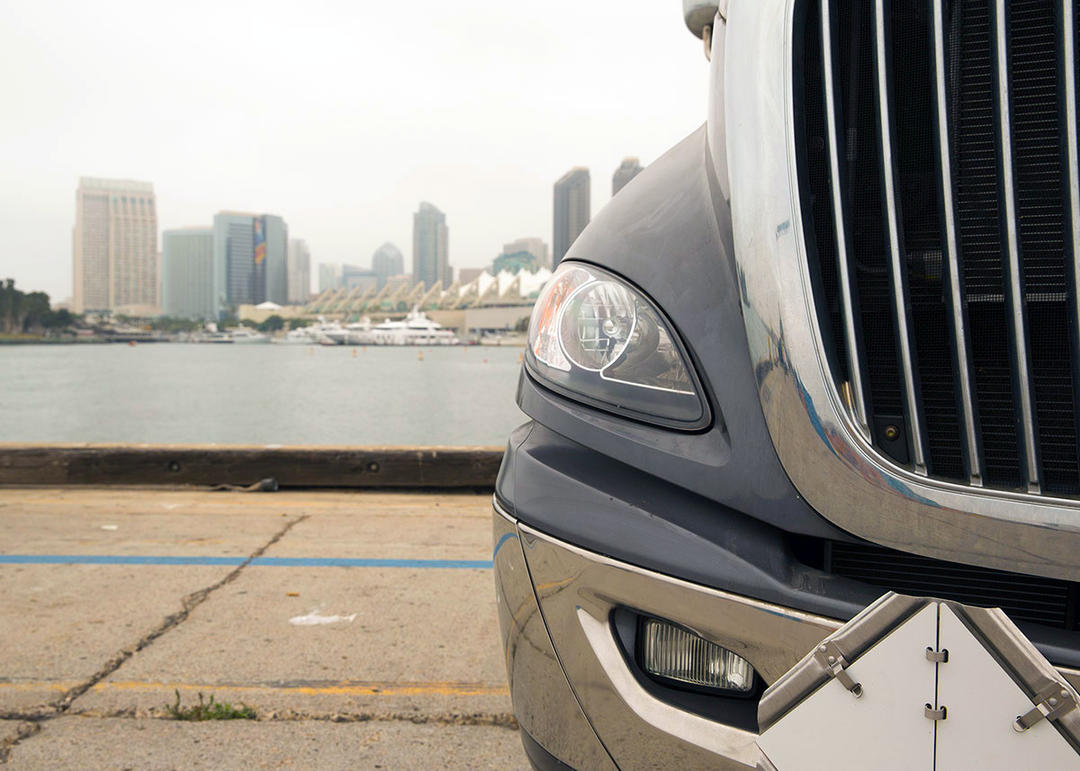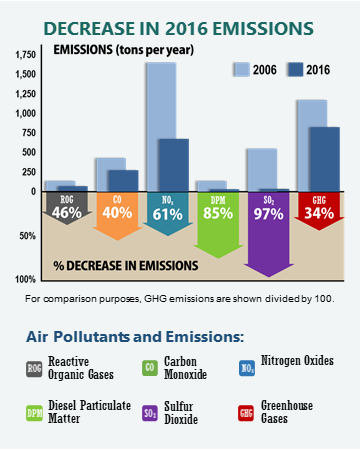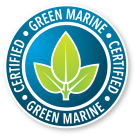Reducing emissions from the Port of San Diego’s maritime operations
The Port is working to improve air quality in our local communities and reduce greenhouse gas emissions. Compared to 2006, air pollutants have decreased between 40% and 97% and GHG emissions fell 34%. A number of programs focus on decreasing emissions from freight transportation including reducing the speed ocean-going vessels travel off of the coast of San Diego, shore powering vessels while at the Port, and advancing alternative fuels and electrification of freight vehicles and equipment along our Working Waterfront.
Green Marine
As champions in the safekeeping and environmental care of San Diego Bay and its diverse ecosystems, the Port of San Diego has enrolled in Green Marine, North America’s largest voluntary environmental certification program for the maritime industry.
Marine Mammal Sightings
The Port is proud to work with partners that are committed to environmental stewardship and education, such as Ocean Connectors. During their whale watching eco-tours in and around San Diego Bay, Ocean Connectors utilizes the publicly available app “Whale Alert” to catalog marine mammal sightings. Click the link below to view a map of their recent sightings and learn more about where marine mammals can be found near San Diego Bay.
Shore Power
Many cruise ships at B Street Cruise Ship Terminal and cargo ships at the Tenth Avenue Marine Terminal plug into shore power to reduce emissions. Shore power saves consumption of fuel that would otherwise be used to power vessels while berthed and eliminates the air pollution associated with consumption of that fuel. As of January 1, 2023, nearly all passenger vessel and refrigerated cargo fleets visiting the Port of San Diego are using much cleaner electricity instead of running their diesel engines while at berth. Beginning, January 1, 2025, roll-on/roll-off carriers will be using shore power as well at National City Marine Terminal.
Vessel Speed Reduction Program (VSR)
The Vessel Speed Reduction Program is a voluntary strategy to reduce air pollutants and greenhouse gas emissions from cargo and cruise ships by reducing speeds in the vicinity of San Diego Bay. Studies show that reducing vessel speeds decreases air emissions which ultimately lead to better air quality. Reduced speeds can also reduce propeller noise, which benefits provides an added benefit to the marine eco system.
Click to get our underwater noise fact sheet
The Port asks cargo vessel operators entering or leaving San Diego Bay to observe a 12-knot speed limit. For cruise ships, a 15-knot limit is requested. The Vessel Speed Reduction zone extends 40 nautical miles seaward from Point Loma.
Click for Voluntary Vessel Speed Reduction Program Participation Summary Report
Trucks and Equipment
The advancement of electric vehicles and alternative fuels are beginning to reshape how we transport freight in and out of our maritime terminals. The Port of San Diego along with its tenants and operators are pioneering the latest technologies, which will drastically reduce emissions from the maritime sector. Through public/private partnerships and innovative pilot projects, the Port will continue to support the next generation of freight vehicles and equipment to improve the environmental condition of our operations.
Documents
Frequently Asked Questions
What is the Clean Air Program?
The Clean Air Program is a comprehensive program that provides a framework for the Port's commitment to reducing air emissions at the Cruise Ship Terminal, Tenth Avenue Marine Terminal and National City Marine Terminal. The 2007 Clean Air Program Report will identify control measures that can be implemented in the near-term and measures that are part of a long-term strategy to reduce air emissions, building upon regulatory and voluntary efforts.
What is the goal of the Clean Air Program?
The goal of the Clean Air Program is to voluntarily reduce air emissions from current Port operations in advance of regulatory action through the identification and evaluation of feasible and effective control measures for each category of Port operations.
What are control measures?
Control measures are structural and operational ways to reduce air emissions. For example, changing the type of fuel used by ocean going vessels is a control measure. Another example would be reducing the speed at which ocean going vessels travel, thus reducing air emissions.
When will the Clean Air Program be completed?
The Board of Port Commissioners is expected to review a draft program in December 2007 and provide direction to Port staff in early 2008. The Clean Air Program will continue to be refined as it moves into the implementation phase in 2008. The Clean Air Program also will be adapted to address air emissions from future changes in Port operations.
What is the Air Emissions Inventory?
In 2007, the Port commissioned an Air Emissions Inventory to identify the sources of air pollutants coming from Port operations. The Port decided voluntarily to conduct the inventory so it could have a baseline of data on which the Clean Air Program could be based. By identifying sources of air pollution, the inventory will help ensure the control measures in the Clean Air Program are effective in reducing air emissions from the areas of greatest concern.
How is the Clean Air Program being developed?
The Port hired a nationally known consultant, ENVIRON, that has worked with ports in Los Angeles, Long Beach, and Oakland on their clean air programs and has conducted port-related work at other ports across the U.S., including the Ports of San Francisco, New York/New Jersey, Houston-Galveston and Hawaii. A stakeholder work group has been formed to provide input into the program, and a draft program will be presented to the Board of Port Commissioners for approval.
Do other ports have clean air programs?
Yes, many ports have developed or are in the process of developing clean air plans, programs, and strategies. The Port and its consultants are familiar with other plans and can benefit from what has been done elsewhere. However, the Port of San Diego is different from other ports in size, type of cargo, and type of operations, and these differences need to be reflected in the Port of San Diego Clean Air Program.
How is the public being involved in the development of the Clean Air Program?
The stakeholder work group represents businesses, residents, labor unions, cities, regulators, environmental groups and other interested parties. Work group meetings are also open to any member of the general public who wishes to provide input. In addition, the public is invited to speak directly to the Board of Port Commissioners when it considers the draft program. Once the program is approved, an ongoing public involvement program will be developed to enable interested stakeholders to provide input as the program is implemented.
Will the Clean Air Program be integrated with the Maritime Business Plan?
The Clean Air Program will identify a clean air strategy that will be applied to all future changes to Port operations, including any that come about as part of the Maritime Business Plan. However, it should be noted that the Port's Maritime Business Plan is a marketing strategy that will guide how the Port could increase its cargo businesses. Actual increases or changes to the Port's maritime cargo business are highly dependent on market conditions and other factors. Once the Port decides to make a specific change in operations, such as increasing a certain kind of cargo or changing the configuration of a marine terminal, the Port will conduct the appropriate environmental review, including air emission control strategies identified in the Clean Air Program.
Will the Clean Air Program undergo an environmental review process?
The Clean Air Program sets forth measures that may be subject to review under the California Environmental Quality Act (CEQA), either independently or as part of development projects.



